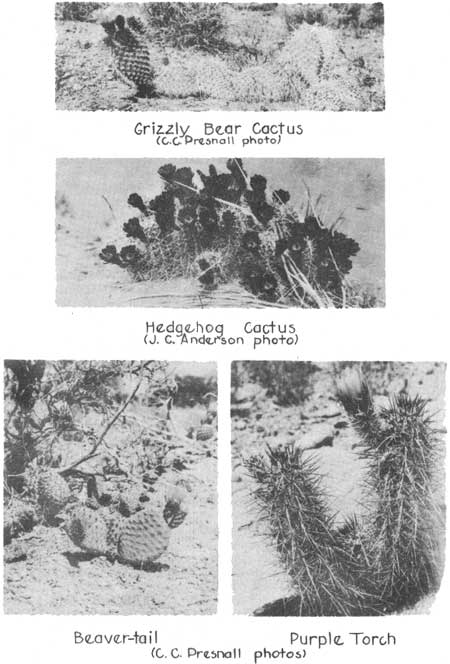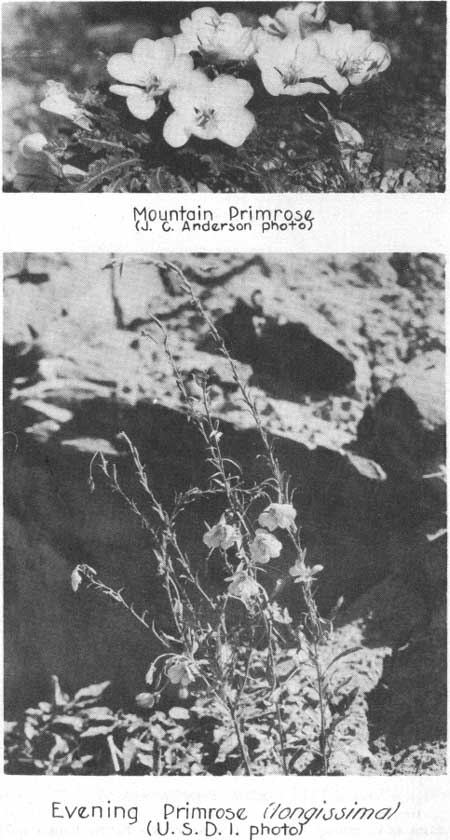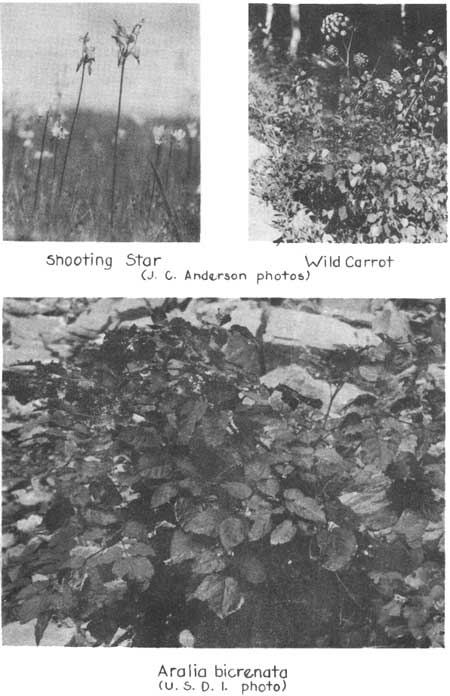|
ZION
Plants of Zion National Park |

|
Zion-Bryce Museum Bulletin
Number 1
PLANTS OF ZION NATIONAL PARK
Families of Plants
(continued)
CACTUS FAMILY (CACTACEAE)
This family is better represented in Zion than in any other national park excepting Carlsbad and possibly Grand Canyon. Most of our species are well illustrated on Plates VIII and IX; and park visitors can see excellent wax reproductions in Zion Museum, hence very little description is necessary here.
HEDGEHOG CACTUS, Echinocereus coccineus. The earliest blooming species in the park, producing numerous dark red flowers in late April and May. Found on warm rocky slopes below 5000 feet.

PLATE VIII
PURPLE TORCH CACTUS, Echinocereus engelmannii. On rocky slopes in the Lower Sonoran Zone this cactus is fairly common, producing beautiful pale purple blossoms in May.
Corypantha arizonica is very rare within the park boundaries, being known from only one place near the lower end of Zion Canyon. It is our only hemispherical cactus, with very pale purple flowers.
CHOLLA, Opuntia acanthocarpa. The only "tree" cactus in the park, common in Lower Sonoran Zone, especially at Coalpits Wash. Desert sparrows often nest in its branches; south of the park where it grows over 6 feet high, several other desert birds do likewise.
ELEPHANT-EAR CACTUS, Opuntia teniuspina. This is the largest of the flat-jointed or "pricklypear" cacti in Zion. Grows on warm slopes in all the major canyons; in June it produces large yellow flowers, followed by conspicuous red fruits.
PRICKLYPEAR, Opuntia rhodantha. The most common cactus in the park, being found almost everywhere. It resembles a small elephant-ear cactus; flowers (late May to July) are various shades of red or salmon. A very similar kind, with lemon yellow flowers, is Opuntia polyacantha, confined chiefly to the Sonoran Zones.
BEAVER TAIL, Opuntia basilaris. The novice may be tempted to handle this cactus because of its lack of spines, but the hair like "glochids" growing in clusters where the spines should be are very painful and difficult to extract from the flesh. A Lower Sonoran Zone species. Light purple flowers.

PLATE IX
GRIZZLY BEAR CACTUS, Opuntia erinacea. In Zion this "wooly" species is confined chiefly to the Lower Sonoran Zone. Red or yellow flowers in May.
CLOCK or DOLLAR CACTUS, Opuntia chlorotica. Rather irregularly distributed on rocky hillsides below 4200 feet. Yellow flowers, in June; one of the latest to bloom.
OLEALSTER FAMILY (ELAEAGNACEAE)
BUFFALOBERRY, Lepargyrea rotundifolia. A low evergreen shrub with small oval leaves that appear to have been painted with a thin coat of aluminum paint through which the green shows faintly. Common on rocky slopes in the Upper Sonoran Zone.
EVENING PRIMROSE FAMILY (ONAGRACEAE)
A large family containing many plants with showy, 4-petaled flowers; altogether different from the true primroses (page 46).
WILD FUSCHIA, Zauschneria garrettii. One of the late blooming species, its red tubular flowers appearing from late July until October. It is not very common, in rocky places in the Upper Sonoran Zone, notably on the Narrows Trail. It can be identified by the narrow oval leaves, pointed and toothed, and the fuschia-like flowers, narrowly funnel-shaped, with the pistil and stamens extending beyond the petals.
WILLOW WEED, Epilobium adenocladon. A slender, narrow-leaved plant with inconspicuous flowers, found in wet places above the Lower Sonoran Zone.
The EVENING PRIMROSES have very showy yellow or white flowers with 4 broad thin petals, blooming at night (or during the day in deep shade). They are among the more conspicuous of the relatively few flowers blooming in Zion during the heat of midsummer, Oenothera longissima (Plate X) and Oenothera strigosa have yellow flowers. The former is usually found in cool canyons; the latter, a much shorter plant, usually grows on sandy soil at middle altitudes, as at east entrance. The two white-flowered kinds, Anogra pallida, and Anogra trichocalyx also grow in sandy places, best seen along the Narrows Trail. The latter cam be identified by its deeply toothed leaves, appearing almost pinnately compound.
The MOUNTAIN PRIMROSE or "rock rose", Pachylophus marginatus, is a very large white evening primrose growing close to the ground from the center of a roseate of long leaves, somewhat resembling a dandelion plant (Plate X). It is found on the east rim, and may also occur on Horse Pasture Plateau.
Other members of this family found in Zion are: Chylismia parryi, Chylismia brevipes, Gaura coccinea, and Gayophytum ramosissimum. All these have small flowers; the first three are confined to the Lower Sonoran Zone, the last one occurs throughout the park.

PLATE X
CARROT FAMILY (APIACEAE)
A large family of herbs containing many edible plants, and some, in more northern regions, that are deadly poisonous. The stems are usually hollow, the leaves compound and often finely divided, and the flowers (and seeds) are borne in umbrella-shaped crowns (umbels), (Plate XI). Identification of the various kinds is often difficult without microscopic examination of the seeds, but the following field characteristics will help in distinguishing the [...missing text...] species known from Zion.
Plants very tall, usually over 2 feet:
WATER PARSNIP, Berula erecta, leaflets are narrow and sharply toothed,
SWEET ROOT, Osmorhiza occidentalis, leaflets oval and round toothed.
Plants medium sized, 6 to 18 inches tall:
Osmorhiza obtusa, oval leaflets.
Cogswellia orientalis, carrot-like leaflets.
Cogswellia triternata, awl-shaped leaflets.
Plants very small, less than 4 inches tall:
Phellopterus utahensis, large umbels.
Cymopterus newberryi, small umbels.
GINSENG FAMILY (ARALIACEAE)
This family, interesting from a medicinal standpoint, is represented in Zion by WILD GINSENG, Aralia bicrenata, a perennial of rank growth closely resembling some members of the carrot family but with stems solid rather than hollow. It has a very limited distribution, being known only from The Grotto and The Narrows above the trail, (Plate XI).
DOGWOOD FAMILY (COPHACEAE)
SILK-TASSEL BUSH, Garrya flavescens. An upright shrub with thick gray-green leaves (opposite and oval) and grayish bark. The flowers are also gray-green, hanging down like silk tassels. In protected canyons of the Upper Sonoran Zone, as at Emerald Pool.
DOGWOOD, Cornus stolonifera. This shrub also has oval opposite leaves, gray-green on the underside only; not so thick as the preceding species, and with prominent veins. It is most easily recognized by its red bark (gray on the larger limbs). In early June it bears round clusters of small white flowers. Found in cool moist canyons.

PLATE XI
INDIAN PIPE FAMILY (MONOTROPACEAE)
In rich soil among the yellow pines on Horse Pasture Plateau one may occasionally see a peculiar plant, PINEDROPS, Pterospora andromedea, which consists of a single reddish-brown stalk about one foot high, apparently without leaves, and with numerous round blossoms or seed pods hanging from short stems. It is a saprophyte, feeding on decaying wood.
HEATH FAMILY (ERICACEAE)
MANZANITA, Arctostaphylos platyphylla. Much of the low chaparral on the plateaus consists largely of this shrub, which is easily recognized by its very crooked red branches and its thick oval evergreen leaves. The Spanish name, Manzanita, "little apple" refers to the dry red berries, used by the Indians for food and in making a pleasant acid drink. Deer and mountain sheep browse on the leaves.
PRIMROSE FAMILY (PRIMULACEAE)
SHOOTING STAR, Dodecatheon pauciflorum. (Plate XI). A very common spring flower (May and June) in such cool moist canyons as The Narrows, where its purple blossoms add to the beauties of the Hanging Gardens. It also occurs in wet places on the plateaus.
BROOKWEED, Samolus floribundus, is an inconspicuous member of this family, found in very wet places in the Upper Sonoran Zone.
OLIVE FAMILY (OLEACEAE)
DESERT ASH, Fraxinus velutina coriacea. (Plate XII). A tree nearly as large as the cottonwood, found along all permanent streams below 5000 feet altitude; but scatteringly, seldom more than 2 or 3 in a place. It is a slow growing tree, fairly long lived, and was much valued by the pioneers for its tough hard wood.
SINGLE LEAF ASH, Fraxinus anomala. An upright shrub or small tree, with the characteristics of an ash excepting that the leaves are simple and entire instead of 5-parted as in the preceding species. It is the principle deciduous tree in the pygmy forest, scattered over all the dry talus slopes in the Upper Sonoran Zone.
GENTIAN FAMILY (GENTIANACEAE)
Two kinds of GREEN GENTIAN occur in Zion: Frasera scabra on the plateaus, and Frasera albomarginata in Coalpits Wash. The former is often called "deer's tongue"; it is a very conspicuous plant, sometimes over 3 feet high, with numerous green 4-petaled flowers on short stems, especially near the top. The petals are spotted with brownish-purple.
A BLUE GENTIAN, Gentiana affinis, has been collected in wet places on Horse Pasture Plateau; it is uncommon, but easily identified, since it is the only plant on the plateau producing conspicuous dark blue flowers in late August or early September.
DOGBANE FAMILY (APOCYNACEAE)
INDIAN HEMP, Apocynum cannabinum. A slender plant about 3 feet high, with a cluster of inconspicuous white flowers at the top, in June. Common in moist places below 5000 feet, as in The Narrows. When mature, the fibrous bark of the stems was used by the Indians to make twine for their finest weaving.
MILKWEED FAMILY (ASCLEPIADACEAE)
The well-known MILKWEEDS are erect plants with milky juice; easily recognized when in fruit by the large boat-shaped pods filled with seeds bearing long silky hairs, by which the wind carries them long distances. There are four kinds in Zion: Asclepias speciosa, tall and robust, with wide gray-green leaves and purple flowers, found in Zion Canyon, not common; Asclepias galioides, slender, with very narrow leaves in whorls, flowers greenish, pods long and narrow, fairly common in Lower Sonoran Zone; Asclepias incarnata, smooth-stemmed with narrow lance-like leaves and reddish flowers, found in the plateaus in damp places; and Asclepias tuberosa, stems quite hairy and leafy, flowers conspicuous orange (in June), found throughout the park above 4000 feet in dry places. This last species is by far the most common one (Plate XII).
DODDER FAMILY (CUSCUTACEAE)
At lower elevations in Zion National Park, especially in the Petrified Forest region, large areas are sometimes seen infested with DODDER, Cuscuta cephalanthi, a parasite that spreads its tangled thread-like yellow stems over all the vegetation, taking nourishment from it by means of aerial rootlets.